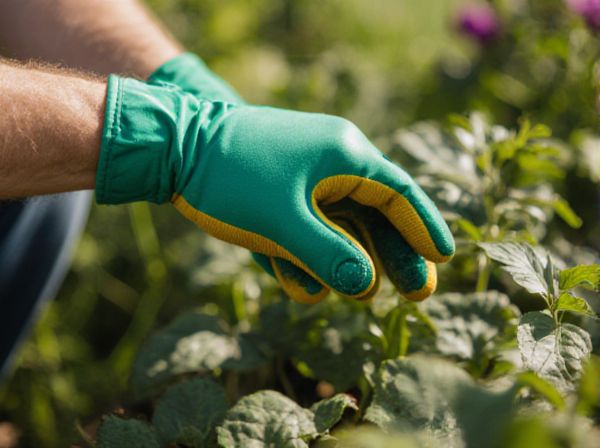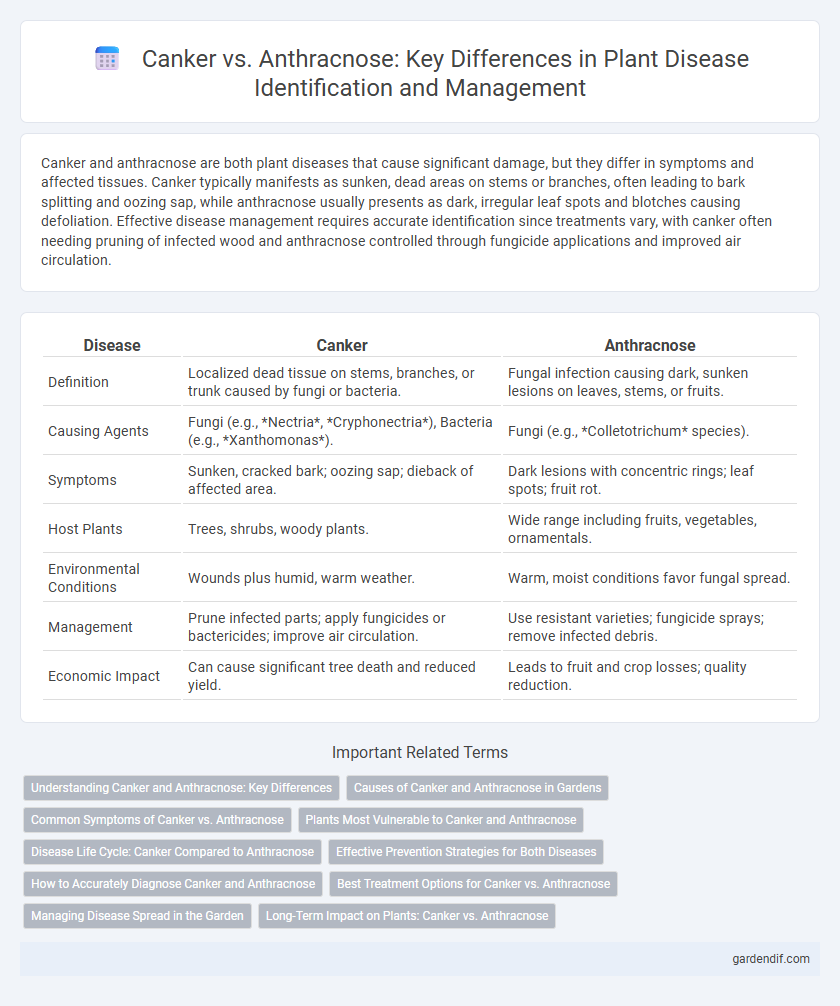
Canker vs Anthracnose Illustration
Canker and anthracnose are both plant diseases that cause significant damage, but they differ in symptoms and affected tissues. Canker typically manifests as sunken, dead areas on stems or branches, often leading to bark splitting and oozing sap, while anthracnose usually presents as dark, irregular leaf spots and blotches causing defoliation. Effective disease management requires accurate identification since treatments vary, with canker often needing pruning of infected wood and anthracnose controlled through fungicide applications and improved air circulation.
Table of Comparison
| Disease | Canker | Anthracnose |
|---|---|---|
| Definition | Localized dead tissue on stems, branches, or trunk caused by fungi or bacteria. | Fungal infection causing dark, sunken lesions on leaves, stems, or fruits. |
| Causing Agents | Fungi (e.g., *Nectria*, *Cryphonectria*), Bacteria (e.g., *Xanthomonas*). | Fungi (e.g., *Colletotrichum* species). |
| Symptoms | Sunken, cracked bark; oozing sap; dieback of affected area. | Dark lesions with concentric rings; leaf spots; fruit rot. |
| Host Plants | Trees, shrubs, woody plants. | Wide range including fruits, vegetables, ornamentals. |
| Environmental Conditions | Wounds plus humid, warm weather. | Warm, moist conditions favor fungal spread. |
| Management | Prune infected parts; apply fungicides or bactericides; improve air circulation. | Use resistant varieties; fungicide sprays; remove infected debris. |
| Economic Impact | Can cause significant tree death and reduced yield. | Leads to fruit and crop losses; quality reduction. |
Understanding Canker and Anthracnose: Key Differences
Canker primarily affects woody plants, causing sunken lesions and tissue death on stems or branches, while Anthracnose targets leaves, stems, and fruits, leading to dark, sunken spots and defoliation. Canker pathogens are often fungal species like Nectria and Cytospora, whereas Anthracnose is commonly caused by fungi in the Colletotrichum genus. Understanding the distinct symptoms, affected plant parts, and causative fungi is crucial for accurate diagnosis and effective disease management.
Causes of Canker and Anthracnose in Gardens
Canker in gardens is primarily caused by fungal pathogens such as Botryosphaeria, Nectria, and Cytospora species that infect tree bark after wounds or stress. Anthracnose results from various fungal genera including Colletotrichum and Gloeosporium, thriving in warm, wet conditions and attacking leaves, stems, and fruits. Both diseases proliferate through spore dispersal via rain splash and infected plant material, emphasizing the need for proper sanitation and environmental management in garden care.
Common Symptoms of Canker vs. Anthracnose
Canker commonly manifests as sunken, dead lesions on stems or branches, often accompanied by oozing sap and cracked bark, leading to dieback in affected areas. Anthracnose typically presents as irregular, dark, sunken leaf spots with chlorotic halos, causing premature leaf drop and defoliation on trees and crops. Both diseases disrupt plant vascular tissues, but canker primarily affects woody structures, while anthracnose targets foliage and young stems.
Plants Most Vulnerable to Canker and Anthracnose
Fruit trees such as citrus, apple, and pear are among the plants most vulnerable to canker, which causes sunken lesions and can lead to bark cracking and dieback. Anthracnose commonly affects plants including maple, oak, and sycamore, resulting in dark, sunken leaf spots and twig dieback. Both diseases thrive in warm, moist environments, increasing susceptibility in orchards and landscapes with poor air circulation.
Disease Life Cycle: Canker Compared to Anthracnose
Canker disease primarily develops through fungal spores entering wounds on woody plants, with infection often occurring during dormant seasons and symptoms appearing in spring. Anthracnose life cycles involve fungi that survive on fallen leaves and infected plant debris, releasing spores during wet, warm conditions that rapidly infect new leaves and shoots. While canker pathogens enter through bark injuries leading to long-lasting lesions, anthracnose fungi repeatedly infect above-ground plant tissues each growing season, causing cyclic defoliation.
Effective Prevention Strategies for Both Diseases
Effective prevention strategies for canker and anthracnose emphasize maintaining proper sanitation by removing infected plant debris and pruning affected branches to reduce pathogen spread. Implementing resistant plant varieties and applying appropriate fungicides during high-risk periods significantly lowers disease incidence. Consistent monitoring and ensuring adequate air circulation also help minimize favorable conditions for both bacterial and fungal pathogens.
How to Accurately Diagnose Canker and Anthracnose
Accurately diagnosing canker and anthracnose involves careful observation of symptoms and laboratory testing. Canker typically presents as sunken, dead areas on bark with resin oozing, while anthracnose causes irregular, dark lesions on leaves and stems. Confirmatory diagnosis requires culturing pathogens or using molecular tests like PCR to differentiate fungal species responsible for each disease.
Best Treatment Options for Canker vs. Anthracnose
Canker treatment typically involves pruning infected branches followed by applying copper-based fungicides to prevent further spread. Anthracnose management requires removing fallen leaves and debris, enhancing air circulation, and using systemic fungicides such as chlorothalonil or thiophanate-methyl. Consistent monitoring and early intervention are crucial for both diseases to ensure effective control and prevent tree damage.
Managing Disease Spread in the Garden
Effective management of canker and anthracnose in the garden requires regular inspection of plants for early symptoms such as sunken lesions for canker and dark, sunken spots for anthracnose. Removing and properly disposing of infected plant debris reduces pathogen sources and minimizes disease spread. Applying targeted fungicides and maintaining optimal garden hygiene, including proper spacing and pruning for air circulation, significantly lowers the risk of infection and transmission.
Long-Term Impact on Plants: Canker vs. Anthracnose
Canker and anthracnose both cause significant long-term damage to plants, but their impacts differ in severity and persistence. Canker infections often lead to the death of bark and underlying tissues, resulting in girdling and branch dieback that can severely weaken or kill trees over time. Anthracnose primarily affects leaves and shoots, causing defoliation and reduced photosynthesis, which can stunt growth but rarely kills mature plants unless infections are severe and recurring over multiple seasons.
Canker vs Anthracnose Infographic

 gardendif.com
gardendif.com